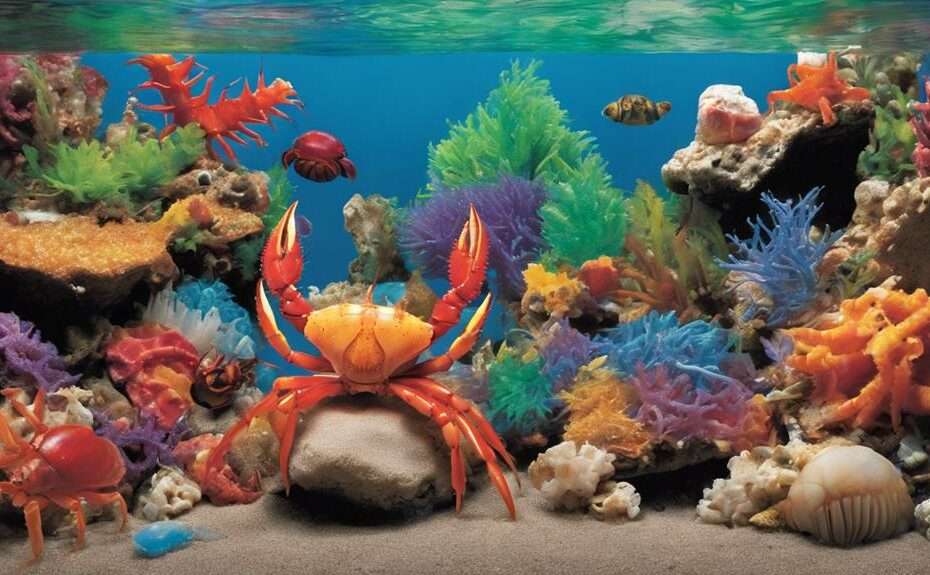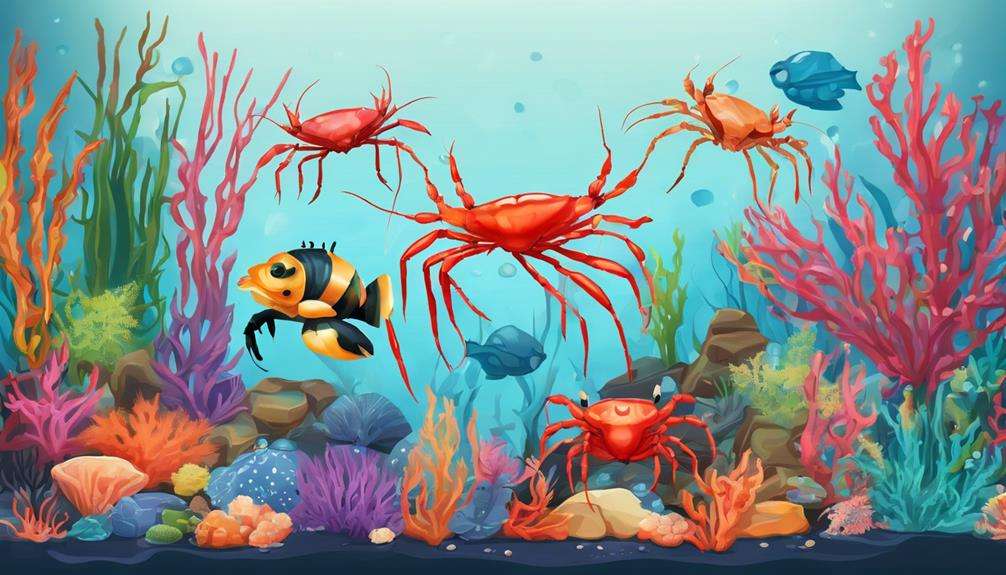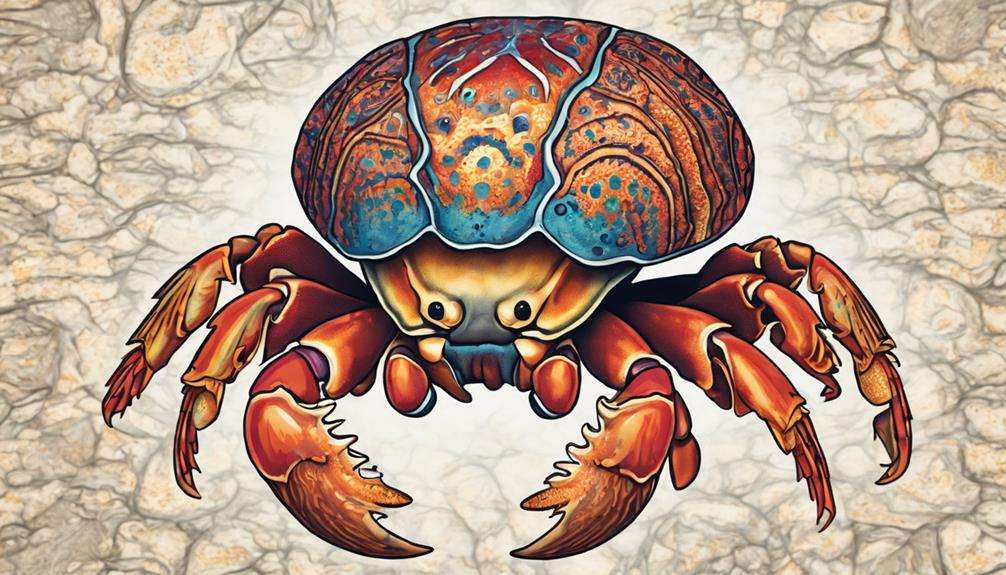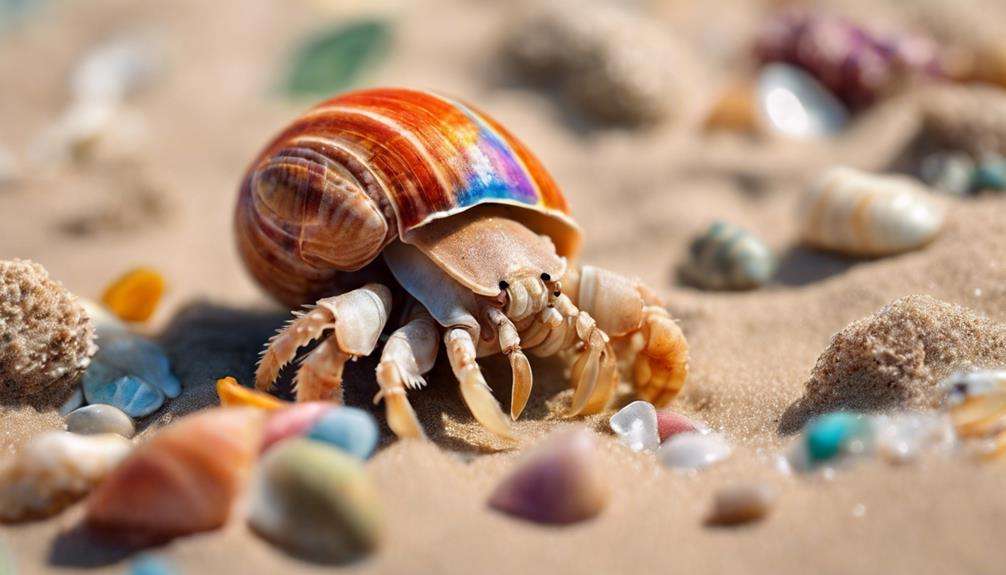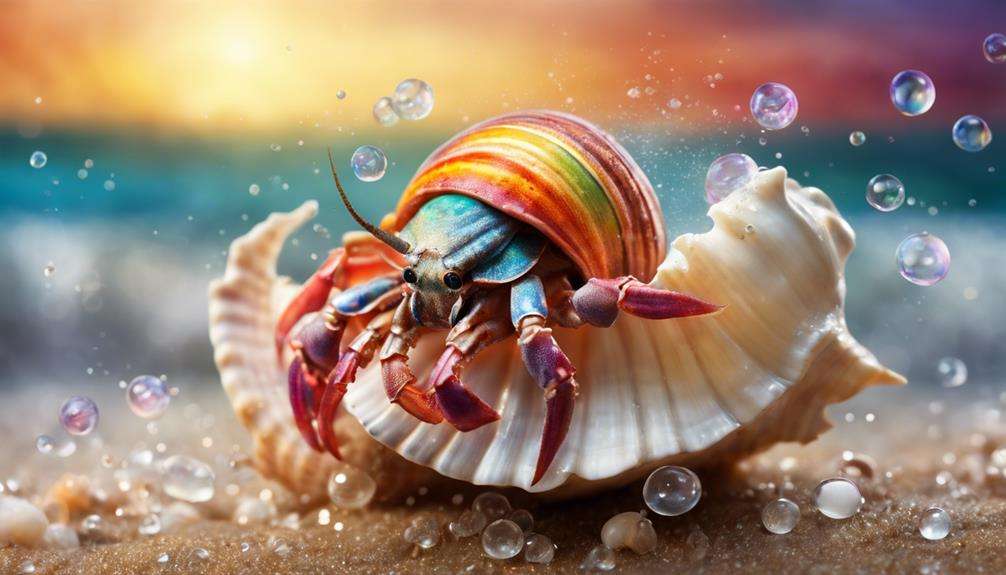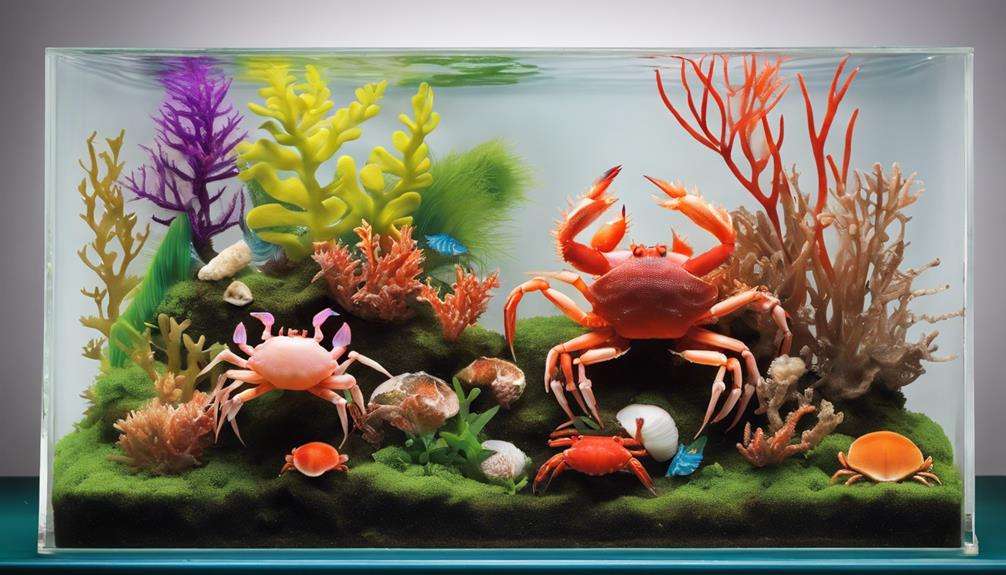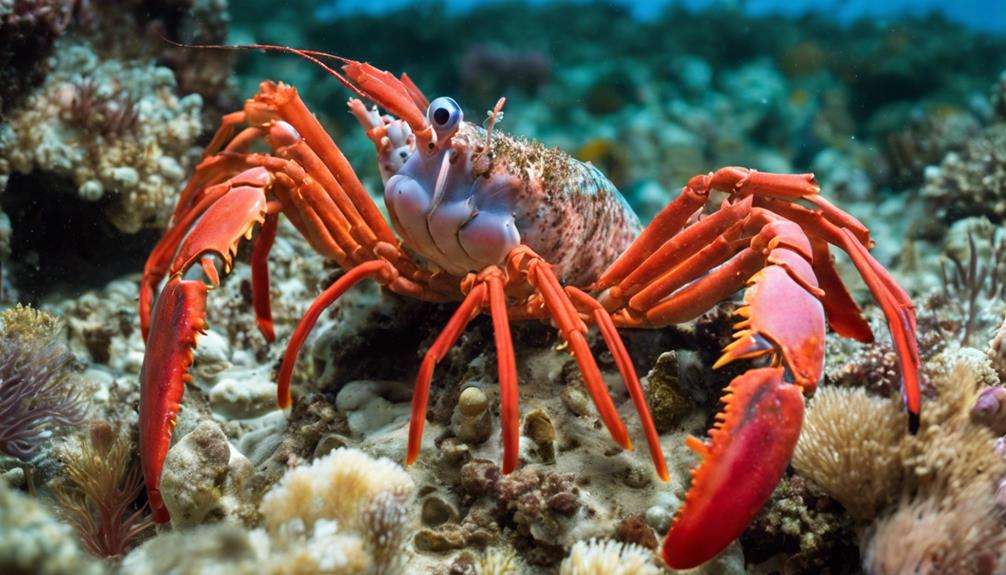Did you know that there are crustaceans out there that can add a whole new level of intrigue to your marine tank? From the Electric Blue Crayfish to the Red Lobster Squat Lobster, each one brings its own unique charm.
However, there are even more fascinating choices waiting to be discovered. These eye-catching creatures not only enhance the aesthetic appeal of your tank but also contribute to its dynamic ecosystem.
Explore the top 10 crustaceans that are sure to captivate your attention and elevate your marine tank to a whole new level.
Key Takeaways
- Mantis Shrimp and Peacock Mantis Shrimp exhibit exceptional predatory behaviors.
- Pom-Pom Crab and Boxer Crab showcase symbiotic relationships with anemones.
- Coral Banded Shrimp and Sally Lightfoot Crab add vibrant colors to marine tanks.
- Cleaner Shrimp and Peppermint Shrimp serve specific roles in tank maintenance.
Electric Blue Crayfish
Electric Blue Crayfish, exhibiting a striking blue coloration, are highly sought after in the realm of aquarium enthusiasts for their vibrant appearance and intriguing behavior. These freshwater crabs, also known as Procambarus alleni, aren't only visually appealing but also serve a practical purpose in aquariums. One notable attribute of Electric Blue Crayfish is their role as efficient cleaners. They're voracious algae eaters, aiding in maintaining a clean and balanced aquarium ecosystem.
In the confined space of an aquarium, algae can quickly accumulate and become a nuisance. Electric Blue Crayfish are valuable allies in combating this issue, as they actively forage for and consume algae, helping to keep the tank clean and free of excessive growths. Their scavenging behavior also extends to leftover food and decaying plant matter, contributing to the overall cleanliness of the aquarium environment.
Aquarium enthusiasts appreciate Electric Blue Crayfish not only for their aesthetic appeal but also for their practical role as diligent cleaners and algae eaters, making them valuable additions to aquatic setups.
Mantis Shrimp
Known for their aggressive predatory behavior and impressive physical capabilities, Mantis Shrimp are captivating creatures that bring a unique dynamic to marine tanks. These crustaceans, belonging to the Stomatopoda order, are renowned for their ability to break through the shells of their prey with their sharp, powerful claws.
In a reef tank setting, it's essential to carefully select tank mates, as Mantis Shrimp may attack and consume smaller fish or invertebrates. Their exceptional eyesight, with some species possessing complex color vision, helps them locate prey with precision.
Mantis Shrimp are skilled hunters, with some using a spearing technique to catch their meals, while others utilize powerful strikes to smash their prey. Their striking speed is so rapid that it can surpass that of a .22 caliber bullet.
Due to their hunting prowess and potential for aggression, maintaining a Mantis Shrimp in an aquarium requires careful consideration and regular monitoring to ensure the well-being of other tank inhabitants and the overall reef ecosystem.
Peacock Mantis Shrimp
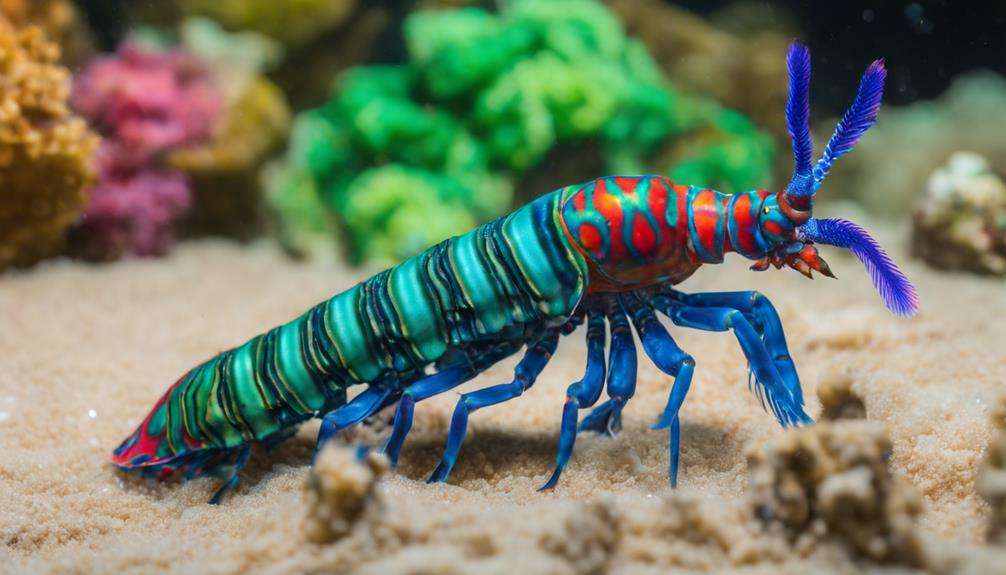
With their vibrant patterns and striking appearance, Peacock Mantis Shrimp are colorful crustaceans that captivate marine tank enthusiasts. These creatures, also known as Odontodactylus scyllarus, are fascinating additions to a reef aquarium but require careful consideration due to their predatory nature. Peacock Mantis Shrimp have powerful appendages that can strike with incredible force, making them skilled hunters of snails, hermit crabs, and even small fish. Their intelligence is evident in their complex behaviors, such as intricate burrowing techniques and hunting strategies.
In a marine tank, Peacock Mantis Shrimp can help control populations of pests like snails and hermit crabs, but their aggressive tendencies must be managed to prevent harm to other tank inhabitants. Ensuring a suitable environment with plenty of hiding spots and a diverse diet including algae and crustaceans is essential for their well-being. Marine enthusiasts who appreciate the beauty and unique behaviors of Peacock Mantis Shrimp will find them to be a captivating and dynamic addition to their aquarium.
Pom-Pom Crab
Peacock Mantis Shrimp, known for their vibrant patterns and predatory nature, share the marine tank spotlight with the fascinating Pom-Pom Crab. Pom Pom Crabs are distinctive for their symbiotic relationship with anemones, which they carry on their claws for defense and foraging purposes. These crabs exhibit a coloration ranging from white to tan, often adorned with darker markings on their bodies, adding to their allure in marine tanks.
One of the notable benefits of having Pom Pom Crabs in your tank is their contribution to the clean-up crew. These crabs actively consume detritus and algae, helping to maintain a healthier tank environment. While they primarily forage for algae and other natural food sources, it's essential to supplement their diet with meaty foods to ensure their nutritional needs are met.
Due to their small size and interesting behavior, Pom Pom Crabs are well-suited for nano aquariums, where their presence can bring both aesthetic appeal and functional benefits to marine tank ecosystems.
Harlequin Shrimp
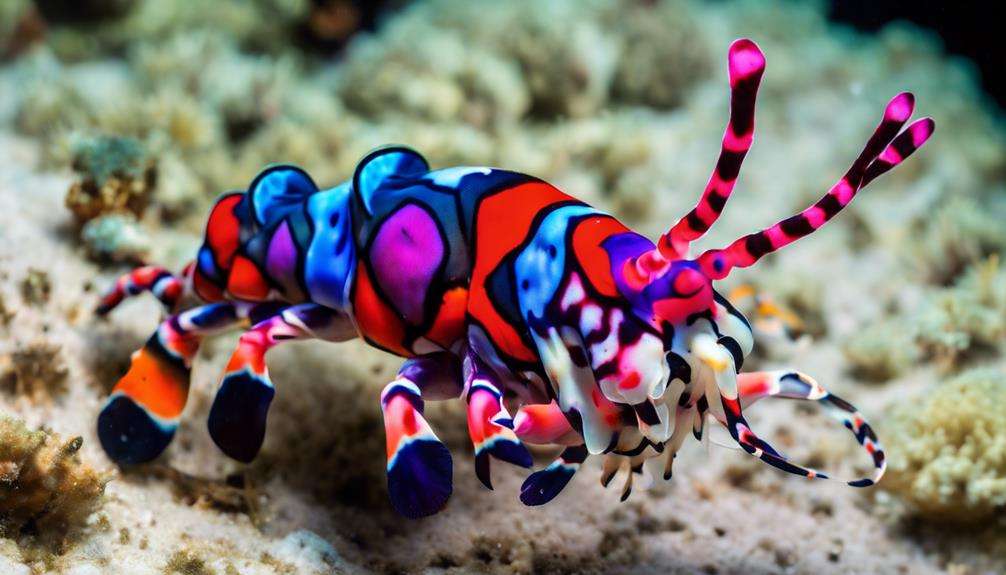
Harlequin Shrimp exhibit fascinating behavior and feeding habits, showcasing their specialized predatory nature towards starfish.
Their vibrant colors and distinct oversized front claws are key adaptations for hunting and tearing apart their prey.
When considering these unique crustaceans for your marine tank, it's crucial to provide them with a controlled starfish supply due to their specific dietary requirements.
Harlequin Shrimp Behavior
Known for their unique feeding behavior of preying on starfish legs, Harlequin Shrimp exhibit a striking appearance with vibrant colors and distinct patterns on their bodies. In marine tanks, these shrimp are often observed meticulously scavenging for food, displaying an intriguing behavior that captivates onlookers.
When kept as part of a clean-up crew, Harlequin Shrimp play a crucial role in maintaining the tank's ecosystem balance. Their interactions with other tank members, like hermit crabs and algae, are minimal due to their specialized diet requirement of starfish legs. It's recommended to provide adequate hiding spaces for these shrimp to reduce stress and ensure their well-being.
Observing Harlequin Shrimp behavior adds a dynamic element to any marine aquarium, making them a popular choice for enthusiasts.
Feeding Habits
Specializing in feeding exclusively on the tube feet of starfish, the Harlequin Shrimp demonstrates unique predatory behavior in marine tanks. These shrimp have evolved a remarkable strategy for immobilizing starfish by flipping them over to access their tube feet, their primary food source.
To sustain a Harlequin Shrimp, one live starfish must be provided every few weeks, making their feeding habits quite particular and demanding. It's essential to carefully select suitable starfish species for their diet to ensure their nutritional needs are met.
Due to this specialized diet, Harlequin Shrimp may not be suitable for all marine tanks, and their feeding requirements must be taken into account when considering their care. If not fed adequately, they may not thrive and could contribute to an algae problem in the tank.
Tank Compatibility
In marine tanks, ensuring suitable tank compatibility for the Harlequin Shrimp is crucial for their well-being and successful care. Harlequin shrimp, known for their preference for starfish, aren't suitable for reef tanks with live corals due to their feeding habits.
When selecting tankmates, caution must be exercised to avoid potential harm to other invertebrates. These shrimp require specific care and feeding routines tailored to their dietary needs to thrive in an aquarium environment.
While they can be kept in pairs, territorial behavior may be exhibited, necessitating careful monitoring. Providing a secure hiding spot within the tank is essential for the Harlequin Shrimp to alleviate stress and promote a sense of security in their habitat.
Arrow Crab
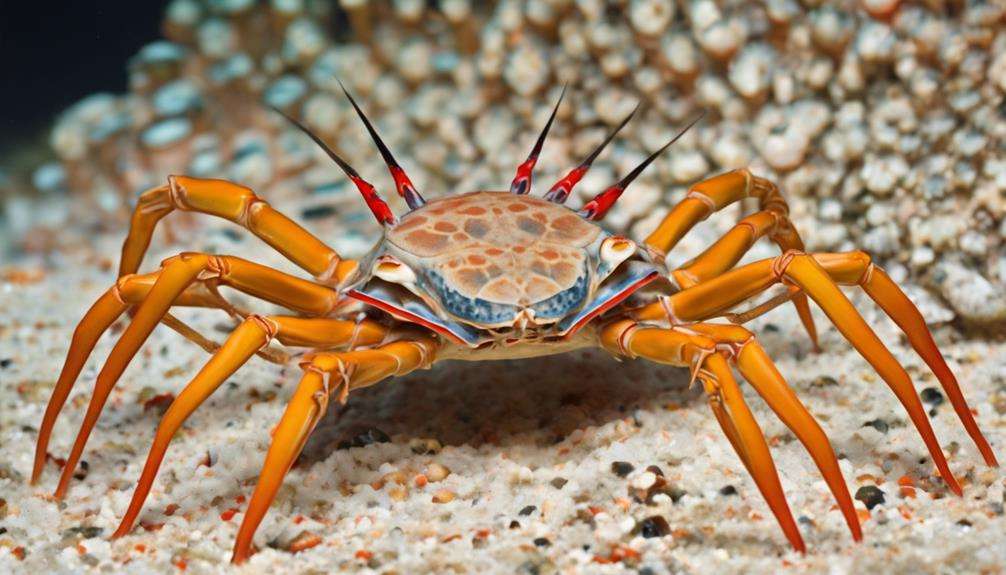
Arrow Crabs, also referred to as Spider Crabs, exhibit a unique predatory behavior in marine tanks. These carnivorous crustaceans are known for their striking appearance and predatory nature, which may not make them suitable for reef tanks with delicate inhabitants.
Here are some key points to consider when keeping Arrow Crabs:
- Diet: Arrow Crabs feed on small invertebrates, using their long, sharp claws to catch and consume their prey.
- Size: These crabs can grow up to 6 inches in captivity, with long, spindly legs and an arrow-shaped body.
- Tank Compatibility: Best kept in species-specific tanks or larger reef tanks with robust tank mates to avoid aggression or competition for food.
- Reef Suitability: Arrow Crabs aren't considered reef safe due to their predatory behavior, making them more suitable for FOWLR setups.
- Behavior: Observing their hunting behavior can be fascinating, as they stalk and capture their prey with precision.
When considering adding an Arrow Crab to your marine tank, it's essential to provide appropriate tank mates and a suitable environment that accommodates their carnivorous and predatory instincts.
Coral Banded Shrimp
The Coral Banded Shrimp, with its vibrant red and white bands, presents a visually captivating sight within marine tanks. These creatures, while colorful and active, serve as valuable reef-safe scavengers by consuming detritus and leftover food in the aquarium.
Interestingly, Coral Banded Shrimp exhibit intriguing social behavior, yet caution is advised due to their aggressive tendencies towards other tank inhabitants.
Colorful and Active
With their striking red and white striped bodies, Coral Banded Shrimp instantly captivate the eye in marine tanks. These colorful and active crustaceans aren't only visually appealing but also serve as beneficial scavengers in a saltwater aquarium. Here are some key observations about Coral Banded Shrimp:
- Constantly on the move, foraging for food and debris in the tank.
- Engage with tank mates, often seen cleaning fish or interacting with other inhabitants.
- Display unique personalities, showcasing interesting behaviors that vary from individual to individual.
- Hardy and easy to care for, suitable for both novice and experienced hobbyists.
- Despite their peaceful nature, they may exhibit aggression towards other shrimp or small crustaceans present in the tank.
Reef-Safe Scavenger
Coral Banded Shrimp, recognized for their vibrant red and white striped bodies, play a crucial role as reef-safe scavengers in marine tanks. These shrimp are instrumental in maintaining tank cleanliness by scavenging detritus and leftover food, which helps improve water quality. Their specialized pincers allow them to access hard-to-reach areas, such as crevices and rock surfaces, contributing to the overall health of the tank ecosystem.
While typically peaceful, they may display territorial behavior towards other shrimp or small crustaceans. Providing hiding spots and ample space is essential when keeping them in pairs to prevent aggression and ensure their well-being. Coral Banded Shrimp aren't only visually striking but also valuable contributors to the ecological balance within marine aquariums.
Intriguing Social Behavior
Exhibiting intricate social behaviors, Coral Banded Shrimp form monogamous pairs that defend territories within marine tanks. These fascinating crustaceans display a range of behaviors that contribute to their social structure and interactions:
- Coral Banded Shrimp communicate through body language and chemical signals, establishing hierarchies within their groups.
- They engage in grooming behaviors, assisting each other in staying clean and healthy.
- Intricate courtship rituals involving antennal tapping and dancing are observed to strengthen pair bonds.
- The shrimp meticulously defend their territories, showing territorial behaviors to protect their space.
- Within marine tanks, Coral Banded Shrimp play a crucial role in the ecosystem by scavenging for food and assisting in controlling pests like bristleworms.
Decorator Crab
Employing a remarkable camouflage technique, the Decorator Crab showcases its ability to blend seamlessly into its marine environment by attaching a variety of materials to its exoskeleton. These crabs, found in marine tanks, use specialized hooks and Velcro-like structures on their exoskeleton to affix decorations like algae and sponges. This adaptation serves as a form of defense against predators, allowing them to disappear among rocks and corals.
What makes the decorator crab truly captivating is its ability to change its decorations frequently, adapting to different habitats and effectively concealing itself. The choice of decorations reflects the crab's creativity and adaptability, offering a mesmerizing display for observers in marine tanks.
Boxer Crab
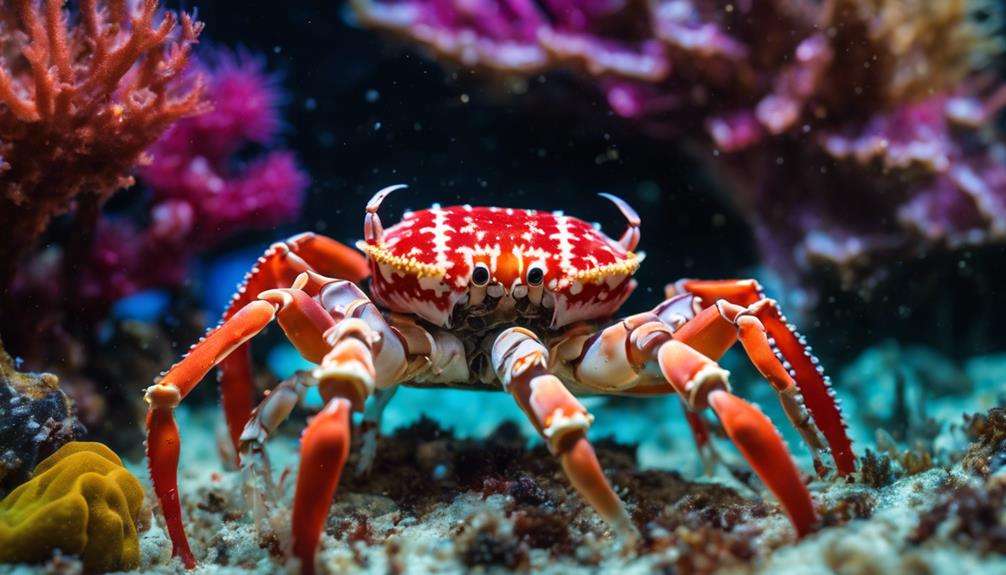
Boxer Crabs, scientifically known as Lybia tessellata, exhibit fascinating behavior with their symbiotic relationship with anemones. These crabs actively seek out anemones to attach to their claws, using them for both defense and hunting.
Observing the interaction between the crab and its 'pom poms' of anemones can provide valuable insights into the intricate dynamics of marine ecosystems.
Boxer Crab Behavior
The specialized behavior of shame face box crabs involves carrying sea anemones in their claws for defense, showcasing a unique adaptation in their natural habitat.
When observing boxer crabs in marine tanks, you may notice the following intriguing behaviors:
- Claw-Carrying: Boxer crabs delicately hold sea anemones in their claws, using them as a form of protection.
- Face Covering: These crabs can fold their claws to cover their faces, resembling a boxer protecting themselves.
- Shell Breaking: Boxer crabs are known to break open shells using their claws, a behavior unsuitable for reef tanks.
- Visual Appeal: The unique appearance and behavior of boxer crabs add interest and charm to marine aquariums.
- Observable Behaviors: In a controlled aquarium environment, the fascinating natural behaviors of boxer crabs can be easily observed and appreciated.
Boxer Crab Care
When caring for pom-pom crabs in marine tanks, ensure a suitable habitat that accommodates their unique symbiotic relationship with anemones. Boxer crabs, also known as pom-pom crabs, exhibit a distinctive behavior by carrying anemones on their claws for defense.
These crabs are typically white to tan with dark markings, making them a visually appealing addition to marine tanks. Their claws provide a platform for the anemones, aiding in protection against predators.
To care for boxer crabs effectively, provide them with live rock or substrate where anemones can thrive. Maintaining stable water parameters and ensuring proper nutrition are essential for the well-being of these crabs and their symbiotic partners.
Understanding and supporting their unique symbiotic relationship with anemones is crucial for successful boxer crab care in marine tanks.
Red Lobster Squat Lobster
With a flattened body, long legs, and striking reddish coloration, the Red Lobster Squat Lobster, scientifically known as Galathea Squat Lobster, stands out as a captivating addition to marine tanks. These fascinating crustaceans, belonging to the Galatheidae family, bring a unique charm to any aquarium setting.
Here are some key facts about the Red Lobster Squat Lobster:
- Red Lobster Squat Lobsters are reef-safe and peaceful tank inhabitants, making them great for community marine tanks.
- They've a scavenging behavior and are omnivores, feeding on detritus, algae, and leftover food in the aquarium.
- Their flattened bodies and elongated legs allow them to maneuver easily among rocks and corals in the tank.
- Red Lobster Squat Lobsters are known for their active scavenging habits, which can be entertaining to observe.
- These crustaceans add both visual interest and a functional aspect to marine tanks by helping clean up excess food and algae.
Frequently Asked Questions
What Are the Best Invertebrates for Marine Aquariums?
For your marine tank, consider unique anemone species that add vibrancy, colorful nudibranch varieties for visual appeal, fascinating starfish types for diversity, and unusual jellyfish species for intrigue. A well-chosen mix enhances your tank's beauty and ecosystem.
What Are the Coolest Reef Safe Crabs?
For reef-safe crabs, consider Arrow Crabs with their carnivorous habits, Anemone Crabs in symbiosis with anemones, Coral Crabs aiding coral growth, and Decorator Crabs camouflaging. Their unique behaviors, colorful patterns, and eye-catching sizes make for fascinating additions.
What Shrimp Are Best for a Reef Tank?
In a reef tank, opt for cleaner shrimp like Peppermint or Blood Red Fire Shrimp for vibrant color and beneficial cleaning. Ensure compatibility with other tank inhabitants and provide ample space for Coral Banded Shrimp's territorial nature.
What Are the Best Algae Eaters for Saltwater Aquariums?
For the best algae eaters in saltwater aquariums, consider coral-friendly snails, seaweed-loving fish, algae-munching hermit crabs, and saltwater cleaner shrimp. These creatures play crucial roles in maintaining a balanced and healthy tank ecosystem.
Conclusion
You simply can't ignore the mesmerizing beauty and captivating behaviors of these top 10 eye-catching crustaceans for marine tanks.
From the vivid colors of the Electric Blue Crayfish to the fierce hunting skills of the Mantis Shrimp, each species brings a unique charm to your underwater world.
Witness the intricate patterns and fascinating movements of these creatures, and let them take your marine tank to a whole new level of excitement and wonder.
Dive in and experience the extraordinary world of marine crustaceans!
